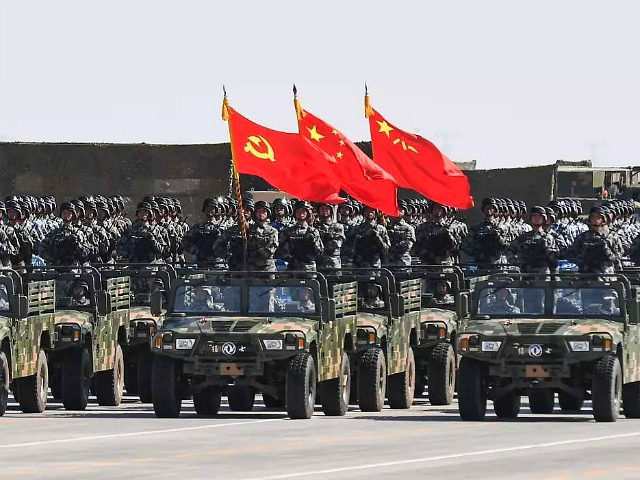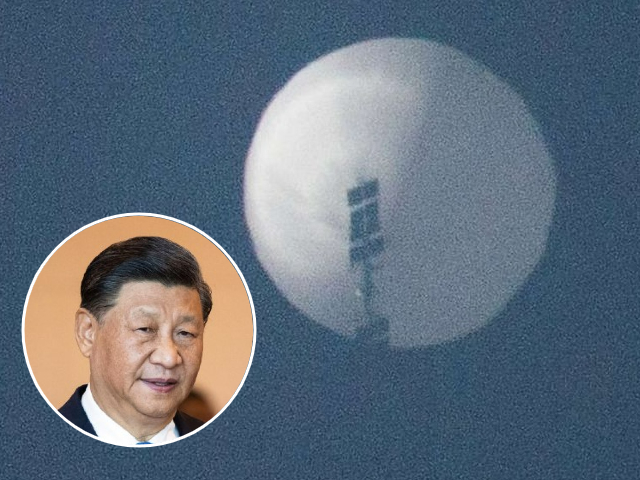The Chinese Defense Ministry loudly protested America’s decision to shoot down a Chinese alleged espionage aircraft over the waters of South Carolina, claiming that taking action to stop the breach of U.S. airspace after the balloon had crossed the entire continental United States and Alaska was an “obvious overreaction.”
The Chinese Defense Ministry suggested it could take reciprocal action against American civilian aircraft, without elaborating.
News began rapidly spreading across social media on Friday of a bizarre, round flying object appearing over the skies of Montana, forcing the administration of leftist President Joe Biden, who has a long history of business ties to China, to announce it had detected an unauthorized Chinese-origin balloon over American land. The Chinese government soon thereafter confirmed – after initially denying any information – that the balloon indeed originated in China, but claimed it had deviated out of the country and into America as a result of force majeure.
Subsequent reports following Friday’s revelation that the Chinese alleged spy balloon had entered America through Alaska and likely traveled down western Canada indicated the Pentagon was “well aware” of its existence as early as January 28, but chose not to comment on it publicly. Social media images of the balloon and public concern reportedly forced a public explanation of the situation.
The Chinese government claimed the balloon was a “meteorological” research vessel for “civilian” purposes that had accidentally left Chinese airspace. The Pentagon initially refused to shoot it down, citing the potential that debris would fall on the grounds and injure Americans, and readied the public for the balloon to “be over the United States for a few days” as of Friday. By Sunday, however, in response to widespread public outrage in America, the Department of Defense confirmed that it had used fighter aircraft to shoot it down.
By the time Biden moved to shoot the balloon and its sophisticated surveillance technology out of American skies, it had crossed from Montana into the waters of the Atlantic Ocean. The Pentagon confirmed the balloon had been destroyed on Saturday.
The Communist Party of China, which started the crisis by violating the sovereignty of the United States, expressed outrage and disgust on Sunday at the Pentagon for taking action, albeit belatedly, on the invading aircraft – and threatened to potentially shoot American civilian aircraft out of the sky.
“The U.S. attack on Chinese civilian unmanned airship by force is an obvious overreaction,” Senior Colonel Tan Kefei, a Chinese Defense Ministry spokesman, said on Sunday. Tan reportedly called the shootdown a “political show.”
The Chinese state propaganda outlet Global Times, which reported Tan’s remarks, noted that he also warned that “China will reserve the right to take necessary measures in dealing with similar situations” and interpreted that to mean that Beijing would consider shooting down American civilian aircraft. The state newspaper also specifically objected to the Pentagon using an F-22 fighter jet to take down the invading balloon, comparing the use of advanced American military technology for the job to “shooting a mosquito with a cannon.”
“Compared with an unmanned, unpowered balloon that flies with the wind, the US interception method that featured an advanced stealth fighter jet and fired a missile is too costly,” the Global Times claimed, citing anonymous Chinese “experts.”
Another regime-approved “expert” told the Global Times that using the F-22 sent the message that Washington was not distinguishing between “civilian and military aircraft,” creating “a very bad precedent.”
The Chinese balloon was unmanned, and its destruction, the Pentagon noted, posed a threat only to those on the ground.
The Chinese Foreign Ministry addressed the balloon incident in much less strident terms than the Defense Ministry. During her regular press briefing on Monday, spokeswoman Mao Ning reiterated that Beijing had no intention of sending the balloon into the United States. Mao indirectly accused Washington, however, of attempting to deteriorate its ties to Beijing.
Calling the balloon crisis “unexpected and isolated,” Mao warned that it “tests … whether the U.S. is sincere about stabilizing and improving its relations with China.”
The entry of the strayed balloon into US airspace was a purely unintended, unexpected and isolated incident. It tests, however, whether the US is sincere about stabilizing and improving its relations with China and whether it can properly manage a crisis. pic.twitter.com/NZY1hQFCdB
— Spokesperson发言人办公室 (@MFA_China) February 6, 2023
In addition to shooting down the balloon, the Biden administration reportedly chose to postpone a visit to Beijing by Secretary of State Antony Blinken. Neither American nor Chinese officials had confirmed the visit, widely reported to have been planned to begin on Sunday and potentially included an in-person meeting with dictator Xi Jinping.
The People’s Daily, the official newspaper of the Chinese Communist Party, reported on Sunday that Blinken held a conversation on Friday with top Politburo member Wang Yi, who was China’s foreign minister until recently, in which Wang berated Blinken about “groundless speculation and hype.”
“China is a responsible country and has always strictly abided by international law. We do not accept any groundless speculation and hype,” Wang reportedly said. According to the state publication, the two diplomats “communicated on how to deal with the incident in a calm and professional manner,” he stated, without elaborating.
The Chinese Foreign Ministry responded to reports of Blinken canceling his Beijing visit by asserting on Saturday, “Neither side has ever announced that there would be a visit.”
China’s insistence that the balloon was a scientific research vessel mirrors its defense of growing bases in the South China Sea – many of them on the soil of foreign countries illegally – that appear to have obvious military uses. The Communist Party has spent the better part of the past decade building artificial islands near the Spratly and Paracel Islands, which belong to the Philippines and Vietnam, and equipping them with advanced surveillance, missiles, and other military assets. Chinese officials have repeatedly insisted the facilities are for marine biology and meteorological research purposes, calling into question its similar claims about the invading balloon.
China also has, however, a lengthy recent history of sending dangerous projectiles into the sky and losing control of them. In 2021, the Chinese government famously launched a giant Long March-5B rocket into space with parts of a planned space station. Upon reentry, Chinese officials lost control of the rocket, threatening the lives of everyone on earth, as Chinese officials could not control or predict where it would land. The rocket ultimately landed safely in the waters off the Maldives but elicited global condemnation nonetheless.
China is “failing to meet responsible standards regarding their space debris,” NASA asserted at the time, prompting Chinese propaganda outlets to accuse NASA scientists of “fussiness.”
More recently, in November, multiple European airports shut down in response to reports of an uncontrolled Chinese rocket once again crash-landing on Earth, potentially on the continent. That rocket landed in the Pacific Ocean without incident but not before shutting down flights in Spain and France.


COMMENTS
Please let us know if you're having issues with commenting.